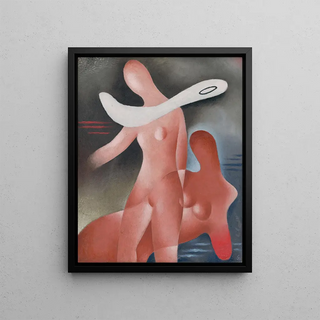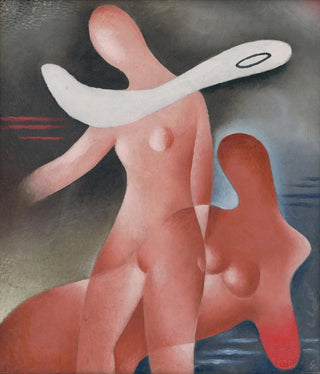Art print | Two women - Mikuláš Galanda


View from behind

Frame (optional)
In the rich and complex universe of art, certain works stand out for their ability to evoke deep emotions and capture the essence of humanity. "Two women" by Mikuláš Galanda is one of those creations that transcend the simple frame of painting to become a true mirror of the human condition. This painting, both intimate and universal, invites us to delve into a visual dialogue between two female figures, revealing stories and feelings that resonate across time. Through this work, Galanda manages to establish an immediate connection with the viewer, sparking curiosity and contemplation.
Style and uniqueness of the work
Mikuláš Galanda's style is characterized by a unique approach that blends expressionist and symbolist influences. In "Two women," the artist skillfully plays with colors and shapes to create an atmosphere that is both vibrant and melancholic. The chosen shades, ranging from soft nuances to more intense flashes, contribute to an emotionally charged ambiance. The female figures, although stylized, exude a strong and authentic presence, almost palpable. Galanda does not merely depict characters; he emphasizes their expressions, gestures, and the dynamic that unites them. This work encourages us to reflect on human relationships, on how individuals perceive and define themselves through others.
The artist and his influence
Mikuláš Galanda, an emblematic figure of 20th-century Slovak art, knew how to mark his era with a rich and varied body of work. His artistic journey is punctuated by experiments that testify to his desire to explore the depths of the human soul. Influenced by European artistic currents, Galanda developed a style that is uniquely his own, blending tradition and modernity. His ability to capture moments of emotional intensity makes him an essential artist. In "Two women," we find this quest for inner truth, where each brushstroke seems to tell a story, a struggle, a connection. The impact of his work goes far beyond Slovak borders, inspiring many contemporary artists to continue exploring human relationships through art.

Matte finish

View from behind

Frame (optional)
In the rich and complex universe of art, certain works stand out for their ability to evoke deep emotions and capture the essence of humanity. "Two women" by Mikuláš Galanda is one of those creations that transcend the simple frame of painting to become a true mirror of the human condition. This painting, both intimate and universal, invites us to delve into a visual dialogue between two female figures, revealing stories and feelings that resonate across time. Through this work, Galanda manages to establish an immediate connection with the viewer, sparking curiosity and contemplation.
Style and uniqueness of the work
Mikuláš Galanda's style is characterized by a unique approach that blends expressionist and symbolist influences. In "Two women," the artist skillfully plays with colors and shapes to create an atmosphere that is both vibrant and melancholic. The chosen shades, ranging from soft nuances to more intense flashes, contribute to an emotionally charged ambiance. The female figures, although stylized, exude a strong and authentic presence, almost palpable. Galanda does not merely depict characters; he emphasizes their expressions, gestures, and the dynamic that unites them. This work encourages us to reflect on human relationships, on how individuals perceive and define themselves through others.
The artist and his influence
Mikuláš Galanda, an emblematic figure of 20th-century Slovak art, knew how to mark his era with a rich and varied body of work. His artistic journey is punctuated by experiments that testify to his desire to explore the depths of the human soul. Influenced by European artistic currents, Galanda developed a style that is uniquely his own, blending tradition and modernity. His ability to capture moments of emotional intensity makes him an essential artist. In "Two women," we find this quest for inner truth, where each brushstroke seems to tell a story, a struggle, a connection. The impact of his work goes far beyond Slovak borders, inspiring many contemporary artists to continue exploring human relationships through art.






